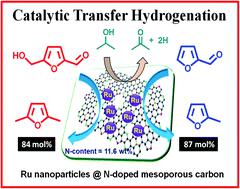当前位置:
X-MOL 学术
›
Sustain. Energy Fuels
›
论文详情
Our official English website, www.x-mol.net, welcomes your
feedback! (Note: you will need to create a separate account there.)
Novel Ru nanoparticle catalysts for the catalytic transfer hydrogenation of biomass-derived furanic compounds
Sustainable Energy & Fuels ( IF 5.0 ) Pub Date : 2020-05-04 , DOI: 10.1039/d0se00361a Atul S. Nagpure 1, 2, 3, 4, 5 , Pranjal Gogoi 1, 2, 3, 4, 6 , Nishita Lucas 1, 2, 3, 4 , Satyanarayana V. Chilukuri 1, 2, 3, 4, 7
Sustainable Energy & Fuels ( IF 5.0 ) Pub Date : 2020-05-04 , DOI: 10.1039/d0se00361a Atul S. Nagpure 1, 2, 3, 4, 5 , Pranjal Gogoi 1, 2, 3, 4, 6 , Nishita Lucas 1, 2, 3, 4 , Satyanarayana V. Chilukuri 1, 2, 3, 4, 7
Affiliation

|
The catalytic transfer hydrogenation (CTH) reaction was investigated for boosting the reduction of biomass-derived furanic compounds to obtain high-quality liquid biofuels. The CTH of 5-hydroxymethylfurfural (HMF) to 2,5-dimethylfuran (DMF) and furfural to 2-methylfuran (MF) was thoroughly studied over the Ru, Pd, Au, Pt, Ni, Rh and Cu metal catalysts supported on nitrogen-doped mesoporous carbons (NMCs) by utilizing 2-propanol as a source of hydrogen. The structural characteristics of the materials were examined by employing various physico-chemical methods, such as XRD, N2 sorption, CHN analysis, XPS, FT-IR spectroscopy, H2-TPR, TEM, CO2-TPD, ICP-OES and Raman spectroscopy. The influence of the N content, basicity of the catalyst, reaction temperature, hydrogen donor, nature of the catalyst support and transition metal was systematically investigated with regard to the substrate conversions and product yields. The correlation between the N content (wt%) of the catalysts and the Ru nanoparticle size (nm) and turnover frequency (h−1) was also investigated. Highly dispersed Ru nanoparticles (1.9 nm) supported on NMC displayed admirable catalytic performance in CTH for the conversion of HMF to DMF and furfural to MF. The catalyst Ru–NMC with a good N content (11.4 wt%) gave 84 and 87 mol% yields of DMF and MF, respectively, with 2-propanol as the source of hydrogen under mild reaction conditions. In addition, this catalyst demonstrated excellent recyclability. The better catalytic activity of the Ru–NMC catalyst in the CTH of HMF and furfural was credited to the small size of the Ru metal nanoparticles (1.9 nm), high N content, superior metal–support interaction and mesoporous framework of the catalyst.
中文翻译:

新型Ru纳米颗粒催化剂,用于生物质衍生的呋喃化合物的催化转移加氢
研究了催化转移氢化(CTH)反应,以促进生物质衍生的呋喃化合物的还原,从而获得高质量的液态生物燃料。在氮气上负载的Ru,Pd,Au,Pt,Ni,Rh和Cu催化剂上,对5-羟甲基糠醛(HMF)转化为2,5-二甲基呋喃(DMF)和糠醛转化为2-甲基呋喃(MF)的CTH进行了深入研究利用2-丙醇作为氢源的掺杂中孔碳(NMC)。通过使用各种物理化学方法,例如XRD,N 2吸附,CHN分析,XPS,FT-IR光谱,H 2 -TPR,TEM,CO 2来检查材料的结构特征-TPD,ICP-OES和拉曼光谱。关于底物转化率和产物产率,系统地研究了氮含量,催化剂的碱性,反应温度,氢供体,催化剂载体和过渡金属的性质的影响。催化剂的N含量(wt%)与Ru纳米颗粒尺寸(nm)和周转频率(h -1)之间的相关性)也进行了调查。在NMC上负载的高度分散的Ru纳米颗粒(1.9 nm)在CTH中表现出令人赞叹的催化性能,可将HMF转化为DMF和将糠醛转化为MF。具有良好N含量(11.4 wt%)的Ru-NMC催化剂在温和的反应条件下,以2-丙醇为氢源,分别得到84和87 mol%的DMF和MF产率。另外,该催化剂显示出优异的可回收性。Ru-NMC催化剂在HMF和糠醛的CTH中具有更好的催化活性,这归因于Ru金属纳米颗粒的尺寸小(1.9 nm),高N含量,优异的金属-载体相互作用和催化剂的中孔构架。
更新日期:2020-06-30
中文翻译:

新型Ru纳米颗粒催化剂,用于生物质衍生的呋喃化合物的催化转移加氢
研究了催化转移氢化(CTH)反应,以促进生物质衍生的呋喃化合物的还原,从而获得高质量的液态生物燃料。在氮气上负载的Ru,Pd,Au,Pt,Ni,Rh和Cu催化剂上,对5-羟甲基糠醛(HMF)转化为2,5-二甲基呋喃(DMF)和糠醛转化为2-甲基呋喃(MF)的CTH进行了深入研究利用2-丙醇作为氢源的掺杂中孔碳(NMC)。通过使用各种物理化学方法,例如XRD,N 2吸附,CHN分析,XPS,FT-IR光谱,H 2 -TPR,TEM,CO 2来检查材料的结构特征-TPD,ICP-OES和拉曼光谱。关于底物转化率和产物产率,系统地研究了氮含量,催化剂的碱性,反应温度,氢供体,催化剂载体和过渡金属的性质的影响。催化剂的N含量(wt%)与Ru纳米颗粒尺寸(nm)和周转频率(h -1)之间的相关性)也进行了调查。在NMC上负载的高度分散的Ru纳米颗粒(1.9 nm)在CTH中表现出令人赞叹的催化性能,可将HMF转化为DMF和将糠醛转化为MF。具有良好N含量(11.4 wt%)的Ru-NMC催化剂在温和的反应条件下,以2-丙醇为氢源,分别得到84和87 mol%的DMF和MF产率。另外,该催化剂显示出优异的可回收性。Ru-NMC催化剂在HMF和糠醛的CTH中具有更好的催化活性,这归因于Ru金属纳米颗粒的尺寸小(1.9 nm),高N含量,优异的金属-载体相互作用和催化剂的中孔构架。











































 京公网安备 11010802027423号
京公网安备 11010802027423号